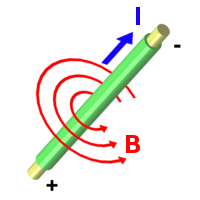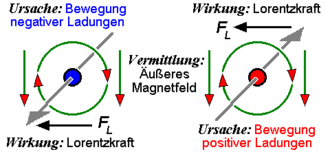Corkscrew rule
The corkscrew rule , alternatively also known as the right-hand rule , the right-thumb rule , screw or encircling rule, is a rule of thumb for clearly determining the direction of the magnetic field generated by a current-carrying conductor . The name of the corkscrew rule as the right-hand rule , which is also used, is not clear, as this is also a synonym for the three-finger rule of the right hand. The dart display common in technical areas enables the compact display of the third dimension of individual elements in a 2D graphic: for "into the picture" (view of the rear end of a dart) and for "out of the picture" (tip of the dart) .
It should also be taken into account that for every “right-fist” or “right-thumb rule” there is a complementary “left-fist rule” or “left-thumb rule” for the opposite direction of the current (i.e. the direction of flow is more negative Charge carrier) can be formulated.
Corkscrew rule, screw rule
If you turn a corkscrew so that it turns in the conventional or technical direction of flow , i.e. H. From the electrical plus to the minus pole, screwing forward, its direction of rotation indicates the direction of the magnetic field lines generated by the current flow, whereby it is assumed that this direction of rotation is always to the right, i.e. clockwise, in conventional corkscrews.
Analogously, when the rule is formulated as "Maxwell's screw rule", it is postulated that if you screw a screw forward in a conventional or technical current direction, its direction of rotation indicates the direction of the magnetic field lines generated by the current flow a screw with a right-hand thread is used.
Right-fist rule, right-thumb rule, wrap-around rule
If the conductor is grasped with the right hand in such a way that the splayed thumb shows the conventional or technical current direction , i.e. H. from the electrical plus to the minus pole, the curved fingers indicate the direction of the magnetic field being generated.
For a circulating current, e.g. B. in the coil of an electromagnet (see below), the following applies accordingly:
If the coil is grasped with the right hand in such a way that the fingers are curved in the direction of the technical current direction , the splayed thumb points in the direction of the magnetic north pole that is being formed.
As indicated, the technical current direction is opposite to the actual direction of movement of the conduction electrons . If, on the other hand, you replace the right hand with the left in the above formulation, you get a rule that takes into account the real direction of movement of the electrons - accordingly referred to as the left-fist or left-thumb rule, however, this rule is opposed to each other the traditional right-fist or right-thumb rule only very slowly, especially in more recent sources.
The basis of the rule is Maxwell's equation or its integral form
Determination of the direction of the Lorentz force
The current in a conductor creates a magnetic field around the conductor, the direction of which is as follows, according to the right-hand rule of thumb: If the current flows in the direction of the thumb through the conductor (to the right in the picture opposite), it forms around it a magnetic field in the direction of the curved fingers (clockwise in the picture opposite). In connection with an external magnetic field - directed transversely to the conductor - there is an increased magnetic field on one side of the conductor and a weakened magnetic field on the other. Field lines in the same direction, however, repel each other, the Lorentz force acts in the direction from the intensified to the weakened magnetic field (to the left in the adjacent picture).
Applications of this principle are electrodynamic drives of all kinds:
- Electric motors
- Voice coils of speakers
- Galvanometer drives, moving coil measuring mechanisms
But electric charges flying freely through a magnetic field also experience a force in the manner and direction described, which deflects them from their original path. As a result of the deflection, however, the direction of the Lorentz force also changes constantly: It always acts at right angles to the direction of movement, i.e. as a centripetal force , which means that moving charges that are deflected by a homogeneous magnetic field, unlike e.g. B. When deflected by a homogeneous electric field, always describe a circular path.
This is used for the magnetic deflection of charged moving particles:
- Deflection of the electrons in the picture tube
- Curvature of the path of charged particles in the cloud chamber
- Distraction and temporary contact-free storage of elementary particles that have been accelerated by particle accelerators in magnetically stabilized storage rings
- Sorting of ions according to type or mass in mass spectrometry
Determination of the polarity of an electromagnet
An electromagnet consists of many conductors in the same direction through which current flows in an open iron core. All conductors filling the winding cross-section each have a surrounding magnetic field whose field lines, since the current directions of all windings are the same, also all run in the same direction and thus add up to a total field encircling the entire winding cross-section. The exit point of this field from the iron core is the end of the coil where the magnetic north pole of the electromagnet is formed according to the right-hand rule of thumb , the reentry point of the field lines in the iron core is the end of the coil where the magnetic south pole is formed.
Since the opposing field lines of adjacent coil windings cancel each other out, as soon as a current flows through them, they tend to come closer to one another and, on the other hand, to enlarge the internal cross-section of the coil due to the mutual repulsion of the parallel field lines inside the coil. On the one hand, coils through which current flows tend to expand transversely to their longitudinal direction, but to contract in the longitudinal direction (principle of the “ Roget's helix ”.)
Electromagnets have numerous applications, from pulling and holding magnets to electric motors to deflecting moving elementary particles and ions in particle accelerators and mass spectrometers, as well as for medical diagnostics with the help of magnetic resonance imaging .
See also
Remarks
- ↑ One of Ampère's two rules is also referred to as a rule of thumb . These come to the same result as the rule described here, but in a different way.
Individual evidence
- ↑ Grimsehl: Textbook of Physics, Vol. II ; Leipzig 1954, p. 116.
- ↑ Dorn-Bader: Physics in one volume, Schrödel, 2006, ISBN 3-507-86266-2 , p. 291.
- ↑ Grimsehl: Textbook of Physics, Vol. II ; Leipzig 1954, p. 145.











